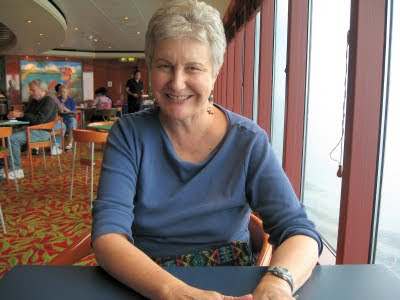 The Alaska we saw on our one week cruise is all about water - misty fjords and majestic glaciers descending from the immense Juneau Ice Field. The two forms of water are sometimes connected directly via tideland glaciers that stretch from the high ice field all the way to the sea. Other times there is a band of rain forest climbing steep hillsides along rushing glacial streams, reaching up from the sea to touch stranded mountain glaciers.
The Alaska we saw on our one week cruise is all about water - misty fjords and majestic glaciers descending from the immense Juneau Ice Field. The two forms of water are sometimes connected directly via tideland glaciers that stretch from the high ice field all the way to the sea. Other times there is a band of rain forest climbing steep hillsides along rushing glacial streams, reaching up from the sea to touch stranded mountain glaciers.This first pictorial narrative covers the initial sea-faring portion of the trip. The glacial episodes follow in a later post.
Debby captured a few moments on the ship.



We played cards a few times and I think I broke even.

Our first port was Ketchikan, a small village on large Revillagigedo Island. It is noted as the fourth wettest locale on Earth.






 Our excursion here was billed the Misty Fjords Wilderness Explorer, a combined whale watching and scenic boat cruise. We traveled up the Behm Canal and into Rudyerd Bay, the fjord we were promised. Just before the turn into the Behm Canal, we encountered almost simultaneously a mother and baby orca pair, and along the shore in the distance, a humpback whale. I have never been fascinated by whale watching from a distance; these photos capture most of the available 'excitement' :). Maybe next time I'll be up close in a small boat and with a wide-angle lens, so as to experience the full impact of such encounters, which for now must exist only in my imagination.
Our excursion here was billed the Misty Fjords Wilderness Explorer, a combined whale watching and scenic boat cruise. We traveled up the Behm Canal and into Rudyerd Bay, the fjord we were promised. Just before the turn into the Behm Canal, we encountered almost simultaneously a mother and baby orca pair, and along the shore in the distance, a humpback whale. I have never been fascinated by whale watching from a distance; these photos capture most of the available 'excitement' :). Maybe next time I'll be up close in a small boat and with a wide-angle lens, so as to experience the full impact of such encounters, which for now must exist only in my imagination.




 New Eddystone Rock is a landmark near the entrance to Rudyerd Bay. First noted by Captain George Vancouver, it appears from a distance to be a ship under sail.
New Eddystone Rock is a landmark near the entrance to Rudyerd Bay. First noted by Captain George Vancouver, it appears from a distance to be a ship under sail. Inside the fjord, we were treated to tranquil scenic beauty. As latitude increases, so does tidal variation. Here we are looking at distances between high and low tide of ~8m. The tidal zone is visible on rock faces. The forest begins just at the high tide mark.
Inside the fjord, we were treated to tranquil scenic beauty. As latitude increases, so does tidal variation. Here we are looking at distances between high and low tide of ~8m. The tidal zone is visible on rock faces. The forest begins just at the high tide mark.








 One native artifact was visible here, a faint rock painting of what appears to be a sun in red outline. Nearby, we saw a pair of bald eagles gracing the top of a snag at the waterline (sadly, no image).
One native artifact was visible here, a faint rock painting of what appears to be a sun in red outline. Nearby, we saw a pair of bald eagles gracing the top of a snag at the waterline (sadly, no image). Small Alaskan towns such as Ketchikan are accessible only by boat or float plane. Supplies are hauled in by barges.
Small Alaskan towns such as Ketchikan are accessible only by boat or float plane. Supplies are hauled in by barges.
Skipping over the glacial sagas for the moment, I end now with our return trip. Our last port of call was Prince Rupert, British Columbia, a small town. We had a short stay, which is appropriate because there is not much that is 'touristy' about the town. Our ship is the only one visiting this year, and next year, even it will switch to Victoria. So we will probably never have opportunity to visit again.
I was interested in the locale because the Queen Charlotte Islands, across Hecate Strait from Prince Rupert, were the setting of a book I read last year, The Golden Spruce.
 The highlight for us here was a great dinner at the Hotel Crest with a nice waterfront view. The food on ship was surprisingly disappointing, on a par with college dorm food we estimated, so we relished this reprieve. It was my first taste of wine from BC; not bad.
The highlight for us here was a great dinner at the Hotel Crest with a nice waterfront view. The food on ship was surprisingly disappointing, on a par with college dorm food we estimated, so we relished this reprieve. It was my first taste of wine from BC; not bad.We awakened Saturday morning back in Elliot Bay. We disembarked in a leisurely manner, possibly among the last ten passengers off. We walked over to the adjacent Hotel Edgewater where we met Dori, Richard and grandkids for brunch before the drive home. The grandkids were pleased with their gifts, an eskimo doll for Emi and a black wolf T-shirt with glow-in-the-dark eyes for Nate.

No comments:
Post a Comment